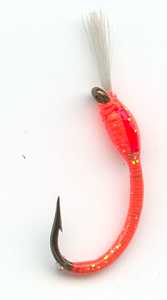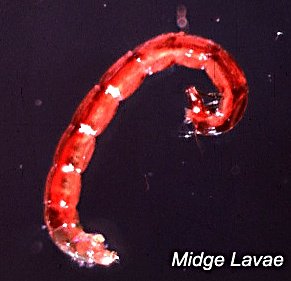Orange Epoxy Buzzer Midge Nymph
When there are midge bloodworm nymph drifting in the river or lake you are fishing then the Orange Epoxy Buzzer Midge nymph fly should be one of the fly patterns you choose to tie onto the end of a dropper.

EPOXY BUZZER MIDGE FLY PATTERNS. Hook size 14 12 - $US each
The single buzzers can be fished just bellow the surface by greasing all but the last three inches of the leader. If there is a single ripple, an occasional twitch of the fly line is enough to attract attention. In flat calm conditions it is usually better to fish the buzzer static in the surface film.
An alternative tactic is to degrease the leader and allow the buzzer to sink very slowly. Using this technique you should be ready for takes 'on the drop', as a trout seizes the buzzer some distance below the surface. I have had many takes sitting this buzzer 2-4 feet below a dry fly used as an indicator and fished close to weed beds in shallow water. In winter this fly has excelled for me when trout are still taking buzzers as part of their diet.
Whether from boat or bank I try a floating line first thing in the morning. Over night many buzzers will have been on the water overnight and some may have even emerge in the early hours. Opportunist fish will often be close to the shore or river bank feeding high in the water after their surface activity.
You will be sight fishing for moving fish as they cruise around the margins. A floating line with a team of epoxy buzzer nymphs imitating the pupae, with maybe a suspender buzzer or Shipman's buzzer on the top dropper. I use a larger heavier epoxy buzzer on the point. The top dropper can entice interest from any surface movement and attract any fish looking upwards. As soon as the fish stop showing in any numbers on the surface, and the buzzers have been plentiful, then the epoxy subsurface patterns come into play. (A 'Dropper' is a length of leader tied to the main leader on which other flies are added.)

The heavier buzzer on the point helps to get the flies down straight in the water as well as aiding turnover in the cast. I find it helpful to present a cast in a straight line. If the flies land in a heap they can often tangle and rarely fish well. Should this happen, in the breeze for example, then a long pull to straighten the leader can be tried. In deep water I use a floating line and a fast sinking Fluorocarbon type of leader material which is nearly invisible under the water.
Sometimes the flies end up under the fish so I fish with a buoyant pattern like a Booby Nymph on the point to suspend the remaining flies higher in the water. I count the nymphs down for about 20 seconds before starting the retrieve. If I hit the bottom I do not immediately pull the line in and recast. If you are fishing more than one fly those still on the dropper are still available to tempt the trout. In these situations I just carry on retrieving slowly.
In clear water I use leaders up to 18 foot long with thee flies spread about 6 foot apart. If they are too close together the trout may become suspicious. If you are a beginner I suggest that you start off with a 12 foot leader with one fly on the point and another placed 6ft up from there on a dropper. Some fishermen like to place a brash bright fly as 'disturbance' fly on the top dropper with epoxy buzzers behind.
The fish often follow the top dropper but as they get near the boat or river bank see the more natural looking buzzer and reject the attraction of the top fly. If it is really windy just use one fly because the more flies you use the more tangles your risk
Boat fly fishing with a newbie
I decided to take Francis, a Belgium police officer friend, boat fly fishing. He lives in the Belgium Ardennes and only fishes rivers and streams. He had never fished from a boat before.
I chose a reservoir that I knew was fully stocked with Rainbows and had lots of bays if the weather got rough. There is nothing worse than taking out a newbie and having a blank day with no fish. That is an instant way to discourage any further boat fishing trips.
I carry a boat box that contains my reels, tackle, lunch, coffee, flies and a drogue which is basically an underwater parachute, to slow the boat's drift. In my other hand I hold my long handled net and two rods.
It was a damp day so we both wore our waterproofs but even on sunny day I pack my waterproofs just in case the weather turns and the weather forecast got it wrong.
Francis had packed his fishing gear in his car as he knew there was a chance we could go fishing on this holiday. I made sure he was armed with a floating and intermediate line. He only had a short 9 foot rod so I lent him one of my spare 10ft 7/8wt rods. I find the extra length gives you more control over the flies close to the boat as you are sat low to the water surface. He was already wearing his buoyancy aid, baseball hat and sunglasses.
While not vital a seat will increase your fishing pleasure immensely and help you avoid back pain at the end of the day. Some boats come already fitted with seats rather than benches. Some fisheries will hire a seat out to customers but any have no provisions for fishermen wanting to use a seat. There boats just have benches in their boats.
At my age I know the advantages of using a seat when fishing. I hate having to deal with an aching back and numb backside. That is why I splashed some cash and purchased two very well padded waterproof swivel boat seats. Do not go for the cheap versions. Go for the best you can afford. It is your comfort you are paying for.
I placed Francis in the bow (the pointy end). When loch-style drift fly fishing, broadside down wind, it is traditionally done with the stern on the left-hand side. This meant that Francis would be casting outside the boat with me casting 'through' the boat. It is best that whenever you go boat fishing the more experienced caster should cast through the boat because it can be dangerous casting over the head of your boat partner.
I make sure that everything you will need once you start fishing is close at hand. I position the landing net with the net head hooked over a rowlock so it doesn’t slip off and fall into the water.
The drogue is positioned in line with the middle seat via a G-clamp attached to the side of the boat. Imagine the drogue as an underwater parachute. It is used to slow down the drifting speed of the boat. It gives you more time fishing and more control over your flies.
The drogue can be moved to alter the drift. Move it closer to the bow and the boat will move right. Move it towards the stern, the back of the boat, and it the boat will move to the left.
Make sure that the drogue is taken out of the water every time you move the boat with the engine otherwise you can cause some engines to overheat because of the extra drag or stop because the drogue gets entangle with the propeller.
I advised Francis to put his fishing bags to his right handside in the front of the boat rather than on his left in the middle of the boat. From experience this saves loose fishing line, stripped with a left hand, getting tangled up with bag buckles and straps. Getting organised in the boat before you go will avoid accidents, frustrations and unnecessary movements once you are afloat.
I find that if there are two of you in the boat it is often a good idea to use different fishing lines and leader. One will use a floating line whilst the other an intermediate line. This enabled you to explore the depths to try and establish where the fish are feeding.
Started Francis off with the floating line and a two fly leader with an orange booby nymph on point and a black epoxy buzzer on a dropper. My idea was to teach him how fast and how slow he can retrieve. As were fishing from a drifting boat, the floating line will show the slack line that immediately occurs as the boat moves.
When this happens it means that you have lost contact with the flies. You therefore need to retrieve to pick up slack line and remain in contact with the flies. It is a very simple technique to learn and after 30 minutes Francis is an expert.
I then swap rods so he can try using an intermediate fly line. Just as he gets his flies a little deeper there is an almost instant take and Francis lands his first-ever trout taken from a boat. He is a very happy Belgium.
I stop him trying to use his short handled fishing net. He has stood up and was trying to lean over to land the Rainbow. The boat started to rock and he was in danger of toppling in. Once I have him seated again I pass him my long handled 2m net. This type of net means you can capture you catch without having to lean out of the boat, whilst seated. It also helps your success rate as the fish are netted before they see the side of the boat, which is when most fish are lost.
I noticed that when Francis cast downwind everything was fine but as soon as he cast to his right it became dangerous for him and myself because his back cast goes across the wind and worse still across the boat. He hooked up the back of his jacket twice. As this was his first time afloat this was to be expected. I kept to casting downwind.
Another thing you should arrange with your partner is to agree to take turns in casting. If one of you starts to cast then the other waits until that person is finished. Doing this avoids those annoying tangles.
Francis, as a first time boat fly fisher, found it difficult to slow down when he brings the flies to the boat. By pausing for up to 20 seconds or more before recasting a fish that has followed the flies will often make a last minute grab. This pause is known as 'the hang' and can be deadly.
After showing him what to do Francis managed to hook his second fish that had tried to snatch at the flies 20 yards from the boat but finally got hooked when it had a second attempt when he held the flies stationary just before attempting to recast them. A fine rainbow was soon in the net.
We had a great mornings fishing in poor weather conditions. We took a total of eight fish between us. Francis is a convert. He is already looking on the internet for the nearest large water fisheries to his home in Belgium. I may have to go on a European road trip soon to explore those locations with him.




Fly Fishing books

